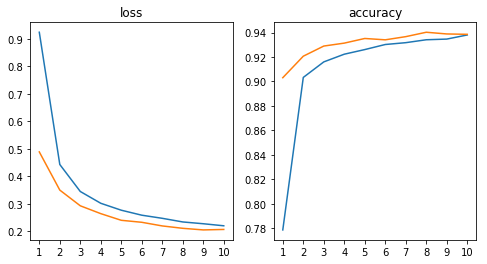学習の様子を可視化できないです。
・ ・ ・ # placeholders input_sequence = Input((story_maxlen,)) question = Input((query_maxlen,)) # encoders # embed the input sequence into a sequence of vectors input_encoder_m = Sequential() input_encoder_m.add(Embedding(input_dim=vocab_size, output_dim=64)) input_encoder_m.add(Dropout(0.3)) # output: (samples, story_maxlen, embedding_dim) # embed the input into a sequence of vectors of size query_maxlen input_encoder_c = Sequential() input_encoder_c.add(Embedding(input_dim=vocab_size, output_dim=query_maxlen)) input_encoder_c.add(Dropout(0.3)) # output: (samples, story_maxlen, query_maxlen) # embed the question into a sequence of vectors question_encoder = Sequential() question_encoder.add(Embedding(input_dim=vocab_size, output_dim=64, input_length=query_maxlen)) question_encoder.add(Dropout(0.3)) # output: (samples, query_maxlen, embedding_dim) # encode input sequence and questions (which are indices) # to sequences of dense vectors input_encoded_m = input_encoder_m(input_sequence) input_encoded_c = input_encoder_c(input_sequence) question_encoded = question_encoder(question) # compute a 'match' between the first input vector sequence # and the question vector sequence # shape: `(samples, story_maxlen, query_maxlen)` match = dot([input_encoded_m, question_encoded], axes=(2, 2)) match = Activation('softmax')(match) # add the match matrix with the second input vector sequence response = add([match, input_encoded_c]) # (samples, story_maxlen, query_maxlen) response = Permute((2, 1))(response) # (samples, query_maxlen, story_maxlen) # concatenate the match matrix with the question vector sequence answer = concatenate([response, question_encoded]) # the original paper uses a matrix multiplication for this reduction step. # we choose to use a RNN instead. answer = LSTM(32)(answer) # (samples, 32) # one regularization layer -- more would probably be needed. answer = Dropout(0.3)(answer) answer = Dense(vocab_size)(answer) # (samples, vocab_size) # we output a probability distribution over the vocabulary answer = Activation('softmax')(answer) # build the final model model = Model([input_sequence, question], answer) model.compile(optimizer='rmsprop', loss='categorical_crossentropy', metrics=['accuracy']) # train hist = model.fit([inputs_train, queries_train], answers_train, batch_size=32, epochs=120, validation_data=([inputs_test, queries_test], answers_test)) model_path1 = 'model1.h5' model.save(model_path1) val_acc = hist.history['val_acc'] plt.rc('font',family='serif') fig = plt.figure() plt.plot(range(240),val_acc,label='acc',color='black') plt.xlabel('epochs') plt.show()
のようにコードを書いて学習の様子を可視化しようとしました。
しかし、何エポックになってもy軸が0のところにずっと線が引かれており学習の様子を可視化できませんでした。学習自体はできており、可視化がだけがうまくいっていないです。なぜうまく行かないのでしょうか?
回答1件
あなたの回答
tips
プレビュー





